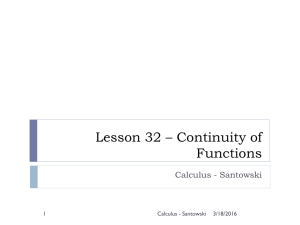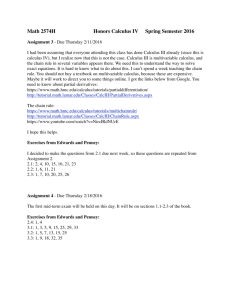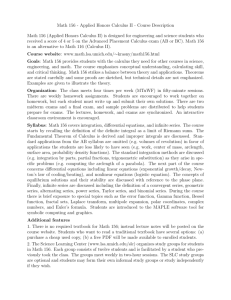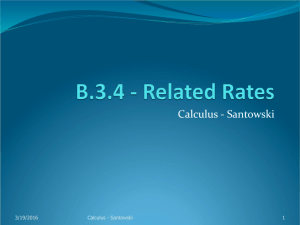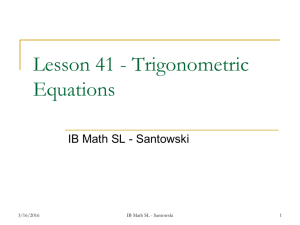C.9.2 - Separable Equations
advertisement
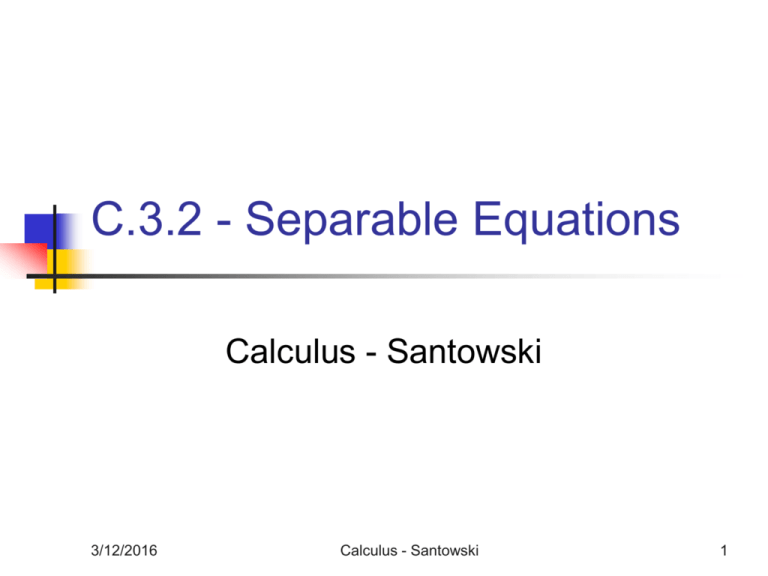
C.3.2 - Separable Equations Calculus - Santowski 3/12/2016 Calculus - Santowski 1 Lesson Objectives 1. Solve separable differential equations with and without initial conditions 2. Solve problems involving exponential decay in a variety of application (Radioactivity, Air resistance is proportional to velocity, Continuously compounding interest, Population growth) 3/12/2016 Calculus - Santowski 2 (A) Separable Equations So far, we have seen differential equations that can be solved by integration since our functions were relatively easy functions in one variable Ex. dy/dx = sinx - 1/x Ex. dv/dt = -9.8 3/12/2016 Calculus - Santowski 3 (A) Separable Equations In Ex 1, we simply evaluated the indefinite integral of both sides dy 1 sin x dx x dy 1 dx dx sin x x dx y cos x ln x C But what about the equation dy/dx = -x/y? If we tried finding antiderivatives or indefinite integrals …. dy x dx y dy dx dx x y dx y ??? 3/12/2016 Calculus - Santowski 4 (A) Separable Equations If we have equations in the form of 1 dy g(y) where , then f (x) g(y) h(y) dx dy f (x) such that h(y) 0 dx h(y) Then we can rewrite the equation as h(y)dy f (x)dx and integrate as before h(y)dy f (x)dx 3/12/2016 Calculus - Santowski 5 (B) Examples dy x Given the DE and y(2) 5 dx y (a) Solve (b) Graph 3/12/2016 Calculus - Santowski 6 (B) Examples 2 y x y and y Given the DE 3 4e 3 (a) Solve (b) Graph 3/12/2016 Calculus - Santowski 7 (B) Examples Given the DE dy dy yy xy and y(2) 1 dx dx (a) Solve (b) Graph 3/12/2016 Calculus - Santowski 8 (B) Examples Given the DE dy xeyx and y(0) 2 dx (a) Solve (b) Graph 3/12/2016 Calculus - Santowski 9 (B) Examples 2 Given the DE dy 6x dx 2y cos y (a) Solve given y 1 (b) Graph the solutions on a slope field diagram 3/12/2016 Calculus - Santowski 10 (B) Example Here is the graphic solution for dy 6x 2 dx 2y cos y 3/12/2016 Calculus - Santowski 11 (C) - Application - Exponential Growth Write a DE for the statement: the rate of growth of a population is directly proportional to the population Solve this DE 3/12/2016 Calculus - Santowski 12 (C) - Application - Exponential Growth Write a DE for the statement: the rate of growth of a population is directly proportional to the population dP P or dt Solve this DE: dP kP dt dP kP dt dP P kdt ln P kt C P(t) e kt C eC e kt P(t) Ce kt 3/12/2016 Calculus - Santowski 13 (D) Examples The population of bacteria grown in a culture follows the Law of Natural Growth with a growth rate of 15% per hour. There are 10,000 bacteria after the first hour. (a) Write an equation for P(t) (b) How many bacteria will there be in 4 hours? (c) when will the number of bacteria be 250,000? 3/12/2016 Calculus - Santowski 14 (D) Examples The concentration of phosphate pollutants in a lake follows the Law of Natural Growth with a decay rate of 5.75% per year. The phosphate pollutant concentrations are 125 ppm in the second year. (a) Write an equation for P(t) (b) What will there be phosphate pollutant concentration in 10 years? (c) A given species of fish can be re-introduced into the lake when the phosphate concentration falls below 35 ppm. When can the fish be re-introduced? 3/12/2016 Calculus - Santowski 15 (E) Homework See handouts (1) Salas, §9.2, p457, Q1-20 (2) Dunkley, §7.5, p371, Q1-7 3/12/2016 Calculus - Santowski 16


